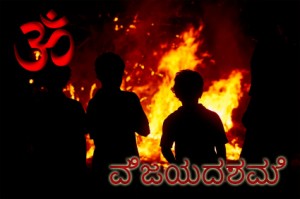
To be an effective interfaith minister, one has to be well-informed about a variety of faiths. Being ordained is only the first step in the process; to truly become a minister, it’s vital to educate yourself about the world’s religions. The Universal Life Church seeks to equip our ministers with the skills and knowledge required to work with people from many different cultural and spiritual backgrounds.
This time of year marks the Hindu celebration of Dussehra. This holiday is determined by the Hindu calendar, which differs from the Gregorian one used by most Westerners in that it is based on the moon rather than the sun. For Hindus, Dussehra is celebrated on the 10th day of the month Ashvin. This means that the holiday generally falls in September or October. This year, Dussehra is on October 24th.
As far as we can tell, the holiday became a widespread celebration in the 17th century. The King of Mysore was responsible for the popularization of the day. He commanded his subjects to celebrate in order to mark the victory of good over evil. A rich tradition of stories surrounds Dussehra.
Chief among these tales is the story of Lord Rama. According to Hindu tradition, Rama, an avatar of Vishnu, defeated and killed the powerful demon Ravana on Dussehra. Rama fought a great battle against Ravana and successfully freed his wife Sita, who the demon had kidnapped. Ravana had ten heads; Rama cut off each of them. The ten heads of Ravana have come to symbolize ten sinful qualities. They include: lust, anger, delusion, greed, pride, jealousy, mind, intellect, will, and ego.
Dussehra is celebrated differently in different regions of India. The largest celebrations occur in northern India, particularly in Delhi. Plays and dances that tell the story of Lord Rama’s life are performed before huge audiences. People build giant effigies of the demon Ravana. After being paraded through the streets, these effigies are burnt in enormous bonfires.
Mysore has some unique Dussehra traditions. This may be due to the large role that the region played in spreading awareness of the holiday. Dussehra festivities in Mysore often feature large parades of elaborately costumed elephants marching through the city streets.
In celebrating the victory of the Divine Lord Rama over the demonic Ravana as good overcoming evil, adherents of Hinduism are honoring their own capacity to overcome the obstacles in their own lives. Many people perform rituals and prayers designed to rid their homes of the ten negative influences already mentioned. The holiday is also considered to be an excellent time to spiritually empower the tools one uses to make a living.
Being an interfaith minister requires becoming familiar with multiple symbolic traditions. Being ordained as a minister with the Universal Life Church opens the door to this lifelong process of learning. Opening to the wisdom of an unfamiliar faith can begin with simple steps. These include learning the basics of religious celebrations. The next step is finding a lesson or practice to incorporate into your own life. How is good defeating evil in your life? What is the Divine rescuing from the demonic? Is there a new project or journey you can start? Dussehra is said to be an excellent time to do so.

